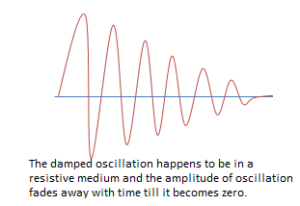Explanation:
When an oscillator, like a pendulum, is

set into vibration and there is no force acting on it then the pendulum keeps on vibrating with constant amplitude and time period. However, this is an ideal situation. In practice, it is quite rare to see a pendulum oscillating with constant amplitude forever.

This is because there is always some force resisting the motion of the oscillator. For example, in case of simple pendulum air resists the motion of the bob. As a result, the pendulum or any oscillator, do work against this resistive force. Therefore, its energy continuously decreases in overcoming this resistance. As the energy of the pendulum decreases, its amplitude also decreases the same way. Finally, the amplitude becomes zero and all the energy of the oscillator is dissipated in the resistive surroundings. Such an oscillation is called damped oscillation (or damped harmonic oscillation).
Pingback:Equations for K.E and P.E in S.H.M … msa – msa
Pingback:Comprehensive Questions on Oscillation, Grade 11 … msa – msa
Pingback:Comprehensive Questions, Oscillation, Physics 11 (new course) … msa – msa